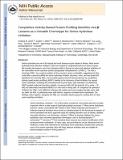Competitive Activity-Based Protein Profiling Identifies Aza-β-Lactams as a Versatile Chemotype for Serine Hydrolase Inhibition
Author(s)
Zuhl, Andrea M.; Mohr, Justin T.; Bachovchin, Daniel A.; Niessen, Sherry; Hsu, Ku-Lung; Berlin, Jacob M.; Dochnahl, Maximilian; Fu, Gregory C.; Cravatt, Benjamin F.; Lopez-Alberca, Maria P.; ... Show more Show less
DownloadFu_Competitive activity-based.pdf (2.364Mb)
PUBLISHER_POLICY
Publisher Policy
Article is made available in accordance with the publisher's policy and may be subject to US copyright law. Please refer to the publisher's site for terms of use.
Terms of use
Metadata
Show full item recordAbstract
Serine hydrolases are one of the largest and most diverse enzyme classes in Nature. Most serine hydrolases lack selective inhibitors, which are valuable probes for assigning functions to these enzymes. We recently discovered a set of aza-β-lactams (ABLs) that act as potent and selective inhibitors of the mammalian serine hydrolase protein-phosphatase methylesterase-1 (PME-1). The ABLs inactivate PME-1 by covalent acylation of the enzyme’s serine nucleophile, suggesting that they could offer a general scaffold for serine hydrolase inhibitor discovery. Here, we have tested this hypothesis by screening ABLs more broadly against cell and tissue proteomes by competitive activity-based protein profiling (ABPP), leading to the discovery of lead inhibitors for several serine hydrolases, including the uncharacterized enzyme α,β-hydrolase domain-containing 10 (ABHD10). ABPP-guided medicinal chemistry yielded a compound ABL303 that potently (IC[subscript 50] ≈ 30 nM) and selectively inactivated ABHD10 in vitro and in living cells. A comparison of optimized inhibitors for PME-1 and ABHD10 indicates that modest structural changes that alter steric bulk can tailor the ABL to selectively react with distinct, distantly related serine hydrolases. Our findings, taken together, designate the ABL as a versatile reactive group for creating first-in-class serine hydrolase inhibitors.
Date issued
2012-03Department
Massachusetts Institute of Technology. Department of ChemistryJournal
Journal of the American Chemical Society
Publisher
American Chemical Society (ACS)
Citation
Zuhl, Andrea M., Justin T. Mohr, Daniel A. Bachovchin, Sherry Niessen, Ku-Lung Hsu, Jacob M. Berlin, Maximilian Dochnahl, María P. López-Alberca, Gregory C. Fu, and Benjamin F. Cravatt. “Competitive Activity-Based Protein Profiling Identifies Aza-β-Lactams as a Versatile Chemotype for Serine Hydrolase Inhibition.” Journal of the American Chemical Society 134, no. 11 (March 21, 2012): 5068-5071.
Version: Author's final manuscript
ISSN
0002-7863
1520-5126